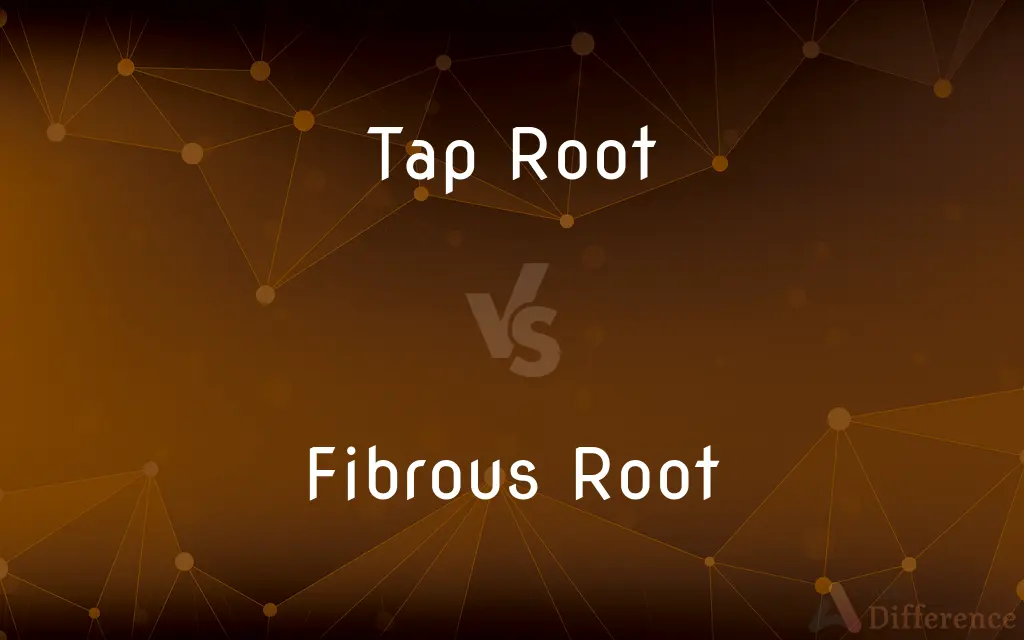Tap Root vs. Fibrous Root — What's the Difference?
Edited by Tayyaba Rehman — By Fiza Rafique — Published on January 9, 2024
Tap root is a single, thick main root with minor branches; fibrous roots are a dense network of thin roots with no main root.

Difference Between Tap Root and Fibrous Root
Table of Contents
ADVERTISEMENT
Key Differences
Tap roots and fibrous roots differ primarily in structure and function. A tap root, like that of a carrot, penetrates deeply into the soil, anchoring the plant and seeking groundwater and minerals from deeper layers. In contrast, fibrous roots, typical of grasses, form a shallow, dense network of roots that can quickly absorb moisture and nutrients from the topsoil, providing a secure hold against soil erosion.
Tap roots can store food and nutrients, acting as reserves during droughts or cold seasons, evident in plants like beetroot and dandelion. Meanwhile, fibrous roots, lacking such storage capacity, are advantageous in nutrient-rich environments where immediate absorption is key. They often outcompete tap-rooted plants in such settings due to their efficient, widespread soil exploitation.
In terms of growth, the tap root system allows for the vertical growth, which is beneficial in arid environments where water is deep underground. Fibrous roots, spreading out in a mat-like fashion, cover more surface area and can quickly colonize the soil, which is why many annual plants, like wheat, have fibrous root systems.
Regarding longevity, tap-rooted plants like trees tend to be perennials, living many years and relying on their deep root systems for survival and stability. Conversely, plants with fibrous roots are often annuals or perennials that need to be hardy in disturbed soils, like those found in flood plains or areas with frequent fires.
In adaptation, the tap root system is well-suited for penetrating hard, compact soils, reaching for deep water sources. Fibrous roots, however, excel in capturing surface water and nutrients before they can percolate away from the root zone, making them ideal for plants in tropical rainforests with heavy rainfall and swift nutrient cycling.
ADVERTISEMENT
Comparison Chart
Main Root Presence
Has a main root
No main root
Growth Direction
Grows deep into soil
Spreads horizontally
Water & Nutrient Absorption
Accesses deep water/minerals
Quickly absorbs surface water/nutrients
Soil Erosion Control
Less effective
More effective
Typical Environment
Arid, undisturbed
Wet, nutrient-rich or disturbed
Compare with Definitions
Tap Root
A tap root is the central, dominant root from which subsidiary roots emanate.
The oak tree's tap root extends deep into the earth.
Fibrous Root
Fibrous roots are typical of monocotyledons.
The fibrous root system of corn supports its rapid growth.
Tap Root
The tap root anchors the plant, providing stability.
Strong winds rarely uproot the pine due to its sturdy tap root.
Fibrous Root
Fibrous roots are often found in plants occupying surface soil layers.
The lettuce's fibrous roots need frequent watering due to their shallow nature.
Tap Root
A tap root is often a storage organ, swelling with nutrients.
The radish, with its bulbous tap root, is a favorite in salads.
Fibrous Root
Fibrous roots form a dense network of roots with no central root.
Grasses stabilize the hillside with their fibrous roots.
Tap Root
Tap root systems are characteristic of dicotyledons.
Botanists identify a plant as a dicot by its tap root structure.
Fibrous Root
Fibrous roots help in soil erosion control by forming a mat.
Fibrous roots of ground cover plants prevent soil washout.
Tap Root
Tap roots can penetrate deeply, seeking groundwater.
The desert's vegetation primarily consists of plants with resilient tap roots.
Fibrous Root
Fibrous roots excel in absorbing moisture and nutrients from the soil.
The newly planted shrubs spread their fibrous roots to capture the rain.
Common Curiosities
Which plants typically have tap roots?
Many dicotyledonous plants, like trees and shrubs, have tap roots.
What is a fibrous root?
A fibrous root system is made up of many small roots that spread out in the soil with no dominant central root.
Which plants have fibrous roots?
Monocotyledonous plants, like grasses and certain flowering plants, typically have fibrous roots.
Can a tap root store nutrients?
Yes, many tap roots act as storage organs and store nutrients.
What is a tap root?
A tap root is the main, central, and dominant root from which other roots sprout laterally.
Do fibrous roots store food?
Fibrous roots generally do not store food; they are more for absorption and anchoring.
What are the benefits of fibrous roots?
Fibrous roots are excellent at preventing soil erosion and quickly absorbing surface nutrients.
How deep can tap roots grow?
Tap roots can grow several feet into the ground, depending on the plant species and soil conditions.
How do tap roots help plants?
Tap roots anchor plants deeply and can access water and nutrients from deeper soil layers.
Can the type of root system change over a plant’s life?
Generally, the type of root system a plant develops initially will persist throughout its life.
Do all plants have either tap or fibrous roots?
Most plants have either tap roots or fibrous roots, but some can have a combination or variations.
Are fibrous roots more common in any particular environment?
Fibrous roots are more common in environments where soil nutrients are near the surface.
Can tap root systems damage foundations?
Yes, large tap roots can potentially grow into foundations and cause damage.
Are tap roots or fibrous roots better for dry environments?
Tap roots are better suited for dry environments due to their deep water access.
Do fibrous roots compete well with other plants?
Yes, the dense mat of fibrous roots can effectively compete for surface nutrients and water.
Share Your Discovery

Previous Comparison
Call vs. Put
Next Comparison
Bank Draft vs. Certified ChequeAuthor Spotlight
Written by
Fiza RafiqueFiza Rafique is a skilled content writer at AskDifference.com, where she meticulously refines and enhances written pieces. Drawing from her vast editorial expertise, Fiza ensures clarity, accuracy, and precision in every article. Passionate about language, she continually seeks to elevate the quality of content for readers worldwide.
Edited by
Tayyaba RehmanTayyaba Rehman is a distinguished writer, currently serving as a primary contributor to askdifference.com. As a researcher in semantics and etymology, Tayyaba's passion for the complexity of languages and their distinctions has found a perfect home on the platform. Tayyaba delves into the intricacies of language, distinguishing between commonly confused words and phrases, thereby providing clarity for readers worldwide.














































